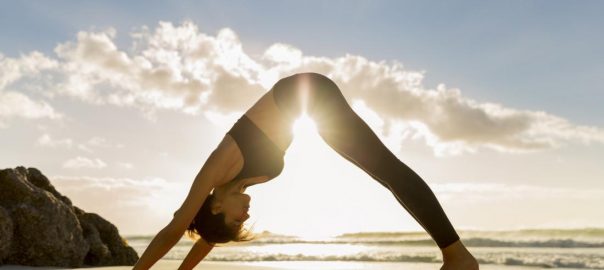
Get the Most out of Easy Yoga for Beginners
How to Get the Most out of Yoga for Beginners
Yoga is by far one of the best ways to get fit, look fantastic, and feel even better.
But if you’re just getting started with yoga, it can be hard knowing what to do. You have lots of choices just figuring out which class to take. There are several schools of thought about how to best approach yoga. And starting off on the wrong foot, or in the wrong class, could turn you off what would otherwise be an extremely rewarding exercise regimen.
So, let’s examine yoga closely to figure out:
- what it is
- what you need to get started, and
- how to get the most out of it
What is Yoga?
Yoga was introduced to the West in the late 19th and early 20th centuries, and since the 1980s has been one of the most popular forms of exercise in North America. But people have been practicing yoga in Asia for millennia.
As best we can tell, yoga was first practiced in India over 2,500 years ago. Yoga is a blend of physical, mental, and spiritual disciplines designed to balance and unify your body, mind, and soul.
While we mostly focus on the physical side of yoga in the West, traditional Indian yoga is deeply spiritual and meditative. Indeed, philosophy itself plays a big part in everyday yoga practices with a strong emphasis placed on metaphysics and the theory of knowledge.
That said, many in the West who pride themselves on secular rationalism still find yoga a wonderful way to stretch and strengthen their muscles. And find some genuine inner peace as well.
All you need to get started
Getting started in a new athletic activity can sometimes involve a huge outlay of cash. Anyone who’s ever followed a whim to take up hockey, bobsleigh or regatta can attest to that. But fortunately, yoga sets the bar low financially. You only need three relatively inexpensive things to get started with yoga
1. Clothes
Yoga apparel doesn’t have to be designer workout wear. In fact, when you show up for your first class, the instructor might appreciate it more if you’re not one of the nameless faces decked out in Lulu Lemon.
What’s the only requirement for yoga clothes? They should be comfortable and loose-fitting. Yoga requires a fair bit of movement and often has you posing in unorthodox positions. You need clothes that will bend with you, keeping you covered without bunching up or restricting your movement.
If you find an old tee shirt and a pair of sweatpants get the job done for you, more power to you.
And the best thing? You don’t need to buy shoes. Almost every sport requires unique and specialized footwear that can really set you back, but yoga is done barefoot. You may want to invest in pedicures more often, but that’s about it.
2. Yoga mat
To help keep those bare feet connected to the ground, you’ll need a yoga mat. Prices for a decent mat start around ten bucks—and it may even come with carrying straps. You can pay more for something thicker, but in the end it’s a rubberized mat. After a certain point, there are only so many bells and whistles you can attach.
3. An open mind
Getting maximum results from yoga begins with a willingness to explore new things with a sense of wonder and adventure. It’s about trying new things without judgement, something many people have hang-ups with. The important thing to remember is that yoga is richly rewarding—see below. It’s so much more than just working out, but you need to approach it with the right attitude to reap the most reward from it.
Why should you do yoga?
Yoga has a ton of benefits for your physical health and your overall sense of well-being. Since yoga postures isolate and strengthen specific muscle groups, yoga makes you stronger and more flexible while reducing your risk of injury in the future.
And doing the poses correctly requires sustained mental focus. Achieving this helps soothe the mind and lower your body’s stress levels. As a side benefit, you’ll have improved powers of concentration in your day-to-day activities.
Yoga also leads to mindfulness by sharpening your focus on energy, movement, and posture. And the longer you hold your poses, the better your stamina and endurance will be.
Regular yoga practice also leads to improved balance and stability. It also raises your body awareness, making you better attuned to your strengths and weaknesses, helping you play to the former and strengthen the latter.
Class or video?
With so much information available about yoga these days, you might be tempted to not take classes. With all the books, blogs and videos out there, why spend money on something you can get in the privacy of your own home much cheaper?
Well, for starters, an experienced yoga instructor—or yogi—has the benefit of third person perspective. They can better see what you might be doing wrong and give you tips to correct that. This can give you powerful insight into overcoming simple mistakes you might not have been aware of. It can also give you the mindfulness you need to perform better when you’re Chromecasting Youtube videos to your TV and doing yoga in your living room.
Even as you get more experienced, still take in a class with an insightful instructor occasionally. Their perspective and experience can help you progress further and quicker than you could ever hope for on your own.
Focus on breath
One thing that may seem odd about yoga is the practice of pranayama—consciously regulated breathing. As you follow your yoga instructor’s guidance, much of what they say is about guiding your breath, controlling when you exhale and inhale.
It’s a concept that might seem out of place for people with a competitive sports background. In most athletic pursuits, it’s all about physical exertion—and the breath just takes care of itself.
That’s where yoga is different. Breath control fosters mindfulness and a focus on the now. Why? Because your mind is easily bored, its internal running monologue hopping from subject to subject with little regard to your mental health.
Pranayama changes all that. By forcing you to think only of your breath, posture, and the movement of your body, there’s little room left for your brain to obsess about other things. Focused breathing sharpens your thought processes and gives you an effective tool for finding peace of mind, anytime.
Nine kinds of yoga explained
There are so many types of yoga available, it can be a little intimidating if you’re a novice. Especially when you could be getting in way over your head by making an ill-advised choice for your first class.
Here are some of the most common forms of yoga and what they’re generally about.
1. Hatha yoga
With its emphasis on slow movements and held poses, hatha yoga is a gentle form of practice ideally suited for beginners.
2. Vinyasa yoga
This form is quick paced and sometimes synced up to pumping music. Vinyasa is yoga for dancers, runners, and anyone else drawn toward continuous movement.
3. Iyengar yoga
For the details-oriented individual, Iyengar is all about precision in form. This form of yoga incorporates props, too—from blocks and blankets to ropes and straps. Even if you’re an experienced yoga student, start Iyengar at the beginner level.
4. Ashtanga yoga
If superheroes did tai chi, it would look like ashtanga yoga. The practice involves six series of flowing poses—and nothing else. Once you get the basics down, there’s nothing left but dedicating your life to mastering the precision of the movements. Seriously, it takes years to get it right. Ideal for type-A personalities.
5. Bikram yoga
Bikram is done in a hot (105°F/40°C) and humid (40% humidity) room. The practice involves a set series of 26 poses as well as two breathing exercises. It’s the same routine everywhere you go. Hydrate well, you’re going to sweat.
6. Hot yoga
Hot yoga is much like Bikram but with more variation in the poses and overall class structure.
7. Kundalini yoga
This branch of yoga appeals to the spiritual side with an emphasis on breathwork and meditation. Get ready to mix repetitive motions with chanting and singing as well.
8. Yin yoga
If ashtanga is one end of the yoga spectrum, yin yoga is its polar opposite. With postures held for several minutes, yin is all about restoring length and elasticity to your connective tissues and fascia. Not recommended if you have a connective tissue disorder.
9. Restorative yoga
As the name suggests, restorative yoga is mellow and slow paced. It’s designed to stimulate your parasympathetic nervous system—the “rest and digest” system—to help you relax better. It’s great for insomniacs and people living with anxiety.
The mystic art of yoga—demystified
While yoga is an effective proven method for strengthening the body and the mind, many people are intimidated by the layers of mystery that surround and enshroud it. Hopefully, this guide has helped clear up some of that confusion and got you pointed in the right direction to make yoga a vital part of your healthy lifestyle.
Just remember, yoga is as much about mind and spirit as it is about physical fitness. Focusing on your breathing while you execute your poses helps clear away the clutter in your mind and will help you think clearer in all aspects of your life.
If you’ve never done yoga before, find a class that appeals to you and give it a shot. And start at the bottom, even if you’re already athletic, and see where it goes from there. That’s the great thing about yoga. With its emphasis on form and precision, a beginner class can offer challenges to participants of all fitness levels. The longer you do a specific set of movements, and the more control you eventually get with them, the more you will benefit from it.






